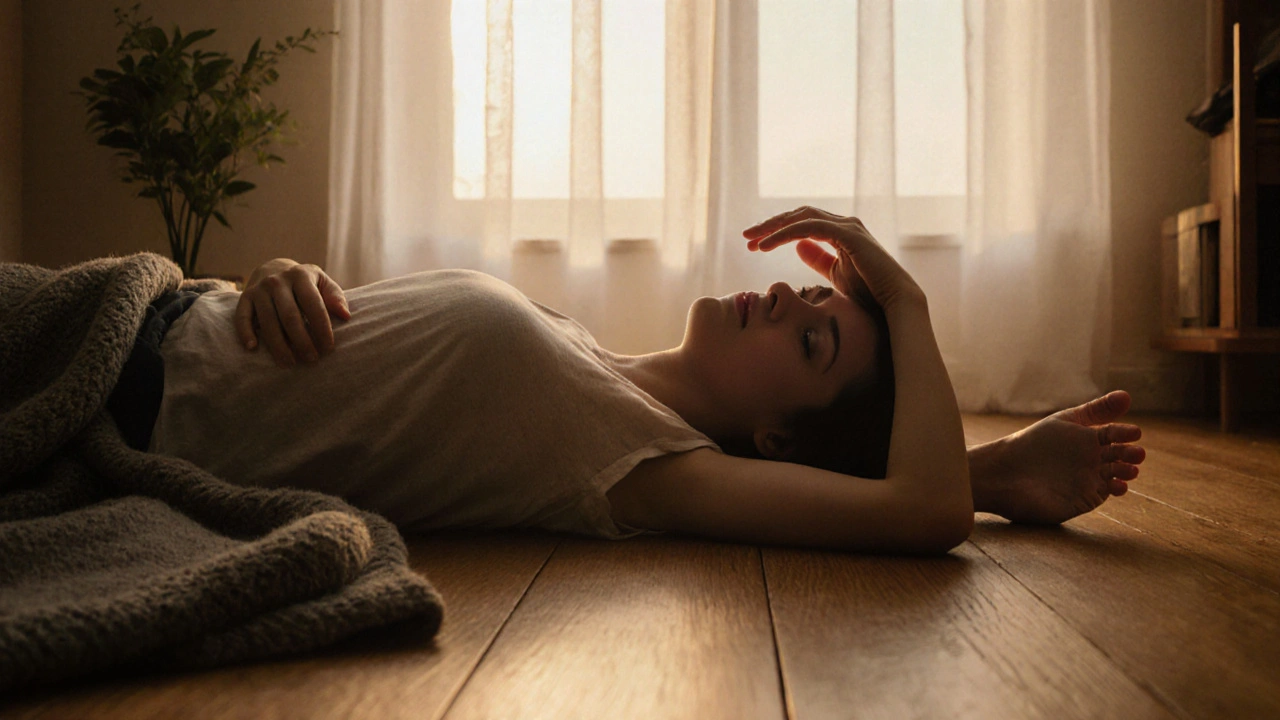Why Polarity Therapy Is the Best Self-Care for Modern Stress
 Nov, 15 2025
Nov, 15 2025
When your body feels heavy, your mind won’t shut off, and even deep breathing doesn’t help-it’s not just burnout. It’s your energy system screaming for balance. That’s where polarity therapy steps in. Not as a quick fix, but as a quiet, consistent practice that rewires how you respond to stress. Unlike massage or meditation alone, polarity therapy works on the invisible currents inside you-the same ones ancient traditions called chi, prana, or life force. It’s not magic. It’s science meeting soul.
What Polarity Therapy Actually Does
Polarity therapy is a system of energy healing developed in the 1960s by Dr. Randolph Stone, a chiropractor, osteopath, and naturopath who studied Eastern and Western healing traditions. He noticed that the human body has natural energy flows, like a battery with positive, negative, and neutral poles. When these flows get stuck-because of stress, trauma, or poor posture-you feel it. Tight shoulders. Constant fatigue. Trouble sleeping. Brain fog.
The therapy uses gentle touch, movement, stretching, and sometimes dietary advice to release blockages and restore the natural rhythm of your energy. Practitioners don’t manipulate muscles like a masseuse. They feel where energy is stuck-like a river dammed by fallen branches-and use light pressure, rocking motions, or specific hand placements to help it move again. It’s not deep tissue. It’s more like tuning a guitar string until it hums true.
Studies from the Journal of Alternative and Complementary Medicine in 2022 showed that participants in polarity therapy sessions reported a 42% reduction in perceived stress levels after just six weekly sessions. Sleep quality improved by 38%. No pills. No needles. Just hands, breath, and presence.
Why It Works Better Than Other Self-Care Routines
You’ve tried yoga. You’ve downloaded meditation apps. You’ve bought expensive candles and salt lamps. But when life throws another curveball-a missed deadline, a sick kid, a fight with your partner-you still feel frayed at the edges. Why? Because most self-care is surface-level. It’s about distraction, not restoration.
Polarity therapy doesn’t ask you to quiet your mind. It helps your body remember how to calm itself. It works on the autonomic nervous system-the part that controls your fight-or-flight response. When energy flows freely, your parasympathetic nervous system kicks in. Your heart rate drops. Your digestion improves. You stop holding your breath without even realizing it.
Think of it like this: if you’ve been running on a treadmill for weeks, no amount of stretching will fix your fatigue. You need to get off the treadmill. Polarity therapy is the off-ramp. It doesn’t add another task to your to-do list. It undoes the tension you didn’t even know you were carrying.
How It Fits Into Daily Life
You don’t need to book a session every week to benefit. Many people start with one or two professional sessions, then learn simple self-practice techniques. The core tools are easy: hand placements, breathing patterns, and mindful movement.
For example: place your right hand on your forehead and your left on your lower belly. Breathe slowly. Feel the warmth. Notice if one side feels tighter. Don’t force anything. Just stay there for three minutes. That’s it. You’re balancing your energy poles.
Another quick move: walk barefoot on grass for five minutes. Feel the ground. Let your toes wiggle. This grounds your negative energy into the earth. It’s called earthing-and it’s one of the oldest forms of polarity work.
People in Brisbane who practice this regularly say they notice changes within days. Less jaw clenching. Fewer headaches. Better sleep. One teacher I spoke to said she stopped taking melatonin after two weeks of daily polarity breathing. Not because it was a miracle. Because her body finally stopped fighting itself.

What It Doesn’t Do
Polarity therapy isn’t a cure-all. It won’t reverse diabetes. It won’t shrink tumors. It won’t replace your therapist or your doctor. It’s not meant to. It’s a support system for your nervous system. Think of it like eating vegetables. You don’t eat kale to cure cancer-you eat it because it helps your body function better.
It also doesn’t require belief. You don’t have to be spiritual. You don’t have to chant. You don’t have to wear crystals. If you’re skeptical, that’s fine. Just try it. Lie down. Breathe. Let someone gently hold your hands in specific positions. If you feel even a little more relaxed afterward, you’ve already experienced the effect.
Who Benefits Most
Polarity therapy isn’t for everyone-but it’s perfect for certain people:
- High achievers who feel constantly on edge
- Parents of young kids who haven’t slept through the night in years
- Healthcare workers or teachers with chronic stress
- People recovering from injury or illness who need gentle support
- Anyone who’s tried everything else and still feels drained
It’s especially helpful for people with anxiety, chronic pain, or insomnia. A 2023 pilot study at a Melbourne wellness center found that 76% of participants with long-term insomnia saw improvement in sleep latency after eight polarity sessions. Not because they were told to sleep better. Because their bodies stopped being stuck in survival mode.

How to Get Started
You don’t need to fly to a retreat center. Start small.
- Find a certified polarity therapist through the International Polarity Therapy Association. Look for someone with at least 500 hours of training.
- Book one session. It usually lasts 60-90 minutes and costs between $80 and $140 in Australia.
- After the session, ask for one simple self-practice technique to do at home.
- Practice it daily for 5 minutes. Consistency matters more than duration.
- After four weeks, reassess how you feel. Not how you look. Not how productive you are. Just how you feel.
If you can’t find a practitioner nearby, look for online guided sessions. Some therapists offer video calls. Others sell audio recordings of polarity breathing exercises. You can even find free guided practices on YouTube-just make sure the instructor is certified.
The Real Secret
The biggest myth about polarity therapy is that it’s about energy. It’s not. It’s about attention.
When you place your hands on your body and breathe slowly, you’re not moving energy. You’re giving your nervous system permission to rest. You’re saying: It’s okay to slow down. You’re safe now.
That’s why it works. Not because of mystical forces. But because modern life never lets us stop. Polarity therapy gives you a legal, gentle, non-judgmental way to pause. And in that pause, your body does the healing.
You don’t need to believe in energy fields. You just need to be willing to sit still. For five minutes. Every day. That’s all it takes to begin.
Is polarity therapy safe for everyone?
Yes, polarity therapy is generally safe for most people, including pregnant women, children, and seniors. It’s non-invasive and uses only light touch. However, if you have a pacemaker, severe osteoporosis, or an active infection, it’s best to check with your doctor first. Always tell your practitioner about any medical conditions before your session.
How long does it take to feel results?
Many people feel calmer after just one session. For lasting changes-like better sleep, reduced anxiety, or less chronic pain-it usually takes 4 to 8 weekly sessions. Like building muscle, energy balance improves with consistent practice. Some people do monthly sessions for maintenance; others only need a few to reset after a stressful period.
Can I do polarity therapy on myself?
Absolutely. While professional sessions are deeper and more targeted, self-practice is the real key to long-term benefit. Simple techniques like hand placements on the head and belly, gentle rocking, or walking barefoot on grass can be done daily. Certified therapists often teach these tools during the first session. You don’t need special equipment-just time and attention.
Does polarity therapy conflict with other treatments?
No. Polarity therapy complements conventional medicine, physical therapy, counseling, and other holistic practices. Many oncology centers, pain clinics, and mental health programs now include it as a supportive therapy. It doesn’t interfere with medications or procedures. In fact, it often helps people tolerate treatments better by reducing stress and improving sleep.
What’s the difference between polarity therapy and Reiki?
Both work with energy, but they’re different. Reiki uses universal energy channeled through the practitioner’s hands, often with no physical contact. Polarity therapy is based on the body’s own energy fields and uses specific touch, movement, and sometimes dialogue to release blockages. Polarity also includes dietary and lifestyle advice tailored to your energy pattern. Reiki is more passive. Polarity is more interactive and grounded in anatomy and physiology.
If you’re tired of self-care that feels like another chore, try polarity therapy. Not because it’s trendy. Not because it’s spiritual. But because it works-quietly, deeply, and without forcing anything. Your body already knows how to heal. It just needs you to stop getting in the way.
